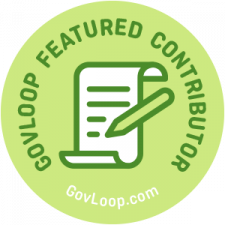 Several year ago, I wrote a blog series about the four envelopes that federal IT must “push” to restore public confidence in our capability to deliver superb citizen information technology services several years ago here on GovLoop.
Several year ago, I wrote a blog series about the four envelopes that federal IT must “push” to restore public confidence in our capability to deliver superb citizen information technology services several years ago here on GovLoop.
- My first blog started with some general background and concluded with my experience as a founding member of the newly formed U.S. Digital Service.
- I introduced the four envelopes in my second blog and gave a brief description of each and what it could add to federal IT.
- My third blog focused on the federal IT Dashboard, what it was doing well, and the several areas where it needed substantial improvement.
- The fourth and, for the time, final blog focused on how a project management office (PMO) should be established within a reorganized CIO’s office within OMB and how the other “envelopes” could also be supported.
Now I want to revisit and bring the first envelope up-to-date and focus in much greater detail on each of the remaining envelopes too over the next several weeks.
What Has Happened (and What Hasn’t)
A lot has happened to the program and project management scene in the federal space since my first several blogs. But unfortunately, a lot has failed to happen too. The single most important event was the passage of the Program Management Improvement Accountability Act (PMIAA) in late 2016. One of the last pieces of legislation signed into law by the Obama administration, this act sought to improve both program management practices and the overall federal approach to program management by reshaping how the federal government staffs the roles that are instrumental to program management within the federal workforce.
Among the actions required by the act, the Office of Personnel Management (OPM) has provided a competency list to the Chief Human Capital Officers (CHCOs), Human Resource Directors, and the CXO Councils. Regrettably, producing this list took over two years and is the precursor to the PMIAA Job Analysis Survey, which has still yet to be released almost four years after the act was passed.
Worse, for the information technology sector of the federal government, both the competencies and the impending survey are focused on the 0340 and 0343 federal job series, which cover the general Program Management series and the Management and Program Analyst series, and not the 2210 IT Program Manager series, which focuses on IT programs and projects. Worse still is the lack of focus on the role of the acquisition workforce: Actual program and project management skills are a barely-mentioned technical competency among the 51 competencies listed and even then not highly ranked in determining grade qualifications for GS-13, 14 and 15 positions.
To keep track of performance under the act, the Government Accountability Office was required to prepare a report to the relevant congressional committees three years after passage of the PMIAA. That report noted that the Office of Management and Budget (OMB) and OPM had begun to implement the act but that the 5-year strategic plan had thus far produced less than detailed standards, and there was no systemic process in place to develop and maintain those standards.
Worse (again), the Program Management Policy Council (PMPC) established by the act has met only a few times over the intervening four years with highly volatile member participation by the CFO Act departments and agencies. OMB and OPM have missed every deadline in the act, and the strategic plan, published six months late, is not scheduled to be updated until the fourth quarter of 2021. Clearly, implementation of the PMIAA is not a high priority for any of the participants identified by the act.
Revisiting the PM Envelope
Given the observed miserable performance on implementing the PMIAA, how does the federal government recover momentum and deliver on providing transparent program and project management envisioned by the first envelope? Suggestions include:
- Pay close attention to the eight GAO recommendations, all of which are directed at the OMB Deputy Director for Management, some in conjunction with the Program Management Policy Council. Unhappily, GAO released their report on December 13, 2019 and as of this blog, the required 180-day response to the recommendations by OMB had not been added to the GAO site for this report. This indicates an even slower than expected execution against implementing the act.
- GAO recommendation three touches on the missing 2210 IT Program Manager role when recommending OMB should broaden the range of program types considered. Given that OPM has not yet created a new series to broadly embrace federal program management, it’s unclear whether the 2210 IT Program Manager role should be folded into the new series or remain within the 2210 series with coordinated competencies and career path. The current arrangement at least has the benefit of there being a 2210 IT Project Manager role which can function as a steppingstone to the IT Program Manager role. If the new series also has a project management career path, combining them would seem apropos. If not, the 2210 series might do better staying separate.
- While the PMPC is only required to meet semi-annually, to catch up they should plan on meeting quarterly until they’ve regained enough schedule to put them back on track. Membership needs to be stabilized so there will be little to no turnover, promoting continuity in council execution. While the Acquisition Workforce group within the PMPC is meeting monthly, it strengthens the focus only on acquisition workforce-related issues and not necessarily on other facets of program management. To be successful, this effort must go beyond ensuring the efficient and effective spending of tax dollars and focus on actually getting program objectives, schedules, and scope criteria managed and met.
- While focused on programs, the PMIAA doesn’t pay sufficient attention to the underlying construct of project management, upon which program management is based. A number of sources have reported that a key stumbling block for PMIAA implementation has been finding a common definition of what a program actually is. This includes the OMB directive that establishes the 5-year implementation goals for PMIAA (OMB 18-19). In many (if not most) cases, a program can be defined by how the projects that constitute it are arranged to provide the deliverables that are needed for program continuity.
Pushing the PM Envelope
While OMB has a portal for the PMIAA on the private MAX web infrastructure that is only open to federal employees, the GAO report identified the lack of a governance structure for further development of the needed standards. A good next step would be to open the portal to input from the academic community and the public at large. One of the key goals of the PM envelope I’ve proposed is transparency. Such a portal would be a valuable first step toward achieving that goal.
Next week I’ll move on to the Enterprise Architecture modeling envelope, even though the post of Chief Federal Enterprise Architect is now vacant and has been for a year.
A retired naval officer, Richard Warren entered public service in 2009. He holds the PMI Project Management Professional, Risk Management Professional, and Agile Certified Practitioner certifications and currently serves on their Federal Sector Executive Roundtable and other PMI executive roles. He also holds the Federal Acquisition Certification in Program and Project Management at the expert level. He was a founding member of the U.S. Digital Service at the request of the Federal Chief Enterprise Architect and the Obama administration.





Leave a Reply
You must be logged in to post a comment.